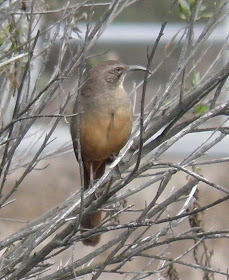 |
| Red-breasted Nuthatch, Sitta canadensis |
So after a rainy Christmas Eve we woke up to beautiful sunshine the next morning and found lots of interesting (that is non-Arizona-desert) birds. A pair of Red-breasted Nuthatches was running up and down a big pine tree in the front yard. I recognized their nasal voices while I was feeding our dogs.
 |
| Western Scrub-Jay, Aphelocoma californica |
On the way from the house to the golfcourse we always hear the scolding calls of Scrubjays, the caws of scores of crows and Cooper's Hawks that are active around their nesting trees even in December. What I really hoped to see were the beautiful, rarely visiting Green Jays, but no such luck.
 |
| American White Pelican, Pelecanus erythrorhynchos |
Against the blue sky, we see three huge white birds slowly cruising towards the golf course ponds: American White Pelicans! They land, and two of them eventually begin their incredibly synchronized fishing ballet. They must be rare visitors, because while I'm trying to film them I get asked over and over whether they are storks, herons, penguins (that's Randy's input). Unfortunately it got all captured on my audio recording.
 |
| Ring-billed Gulls, Laurus delawarensis |
 |
| White-tailed Kite, Elanus leucurus |
A White-tailed Kite was preening on top of a cypress at a very busy intersection. He waited there for me to go home and come back with my camera.These graceful raptors were among my favorites when I lived in Laguna Niguel, CA where they hovered and soared over the canyon behind our house on every sunny morning.
 |
| White-Tailed Kites by Stan Keiser |
 |
| California Trasher, Toxostoma redivivum |
 |
| California Towhee, Pipilo crissalis |
Some Towhees seemed to be a dark maroon color through my new binoculars. But I had been warned that the glasses do not have the best color correction capacity, and sure enough, my trusty little camera detected much less of a reddish cast on those birds. Anyway, both California Trasher and California Towhee are endemics and 'lifers' for me. I might have seen them before, but this is the first time I paid enough attention to identify them. Actually, I just realized that my old National Geographic bird guide still lumps California and Canyon Towhee together: Brown Towhee. Only my newer Sibley guide introduced me to the California species. Defining characters of the pacific species seems to be the lack of a black spot on his chest and darker chest plumage.
 |
| Canyon Towhee, Pipilo fuscus |

















